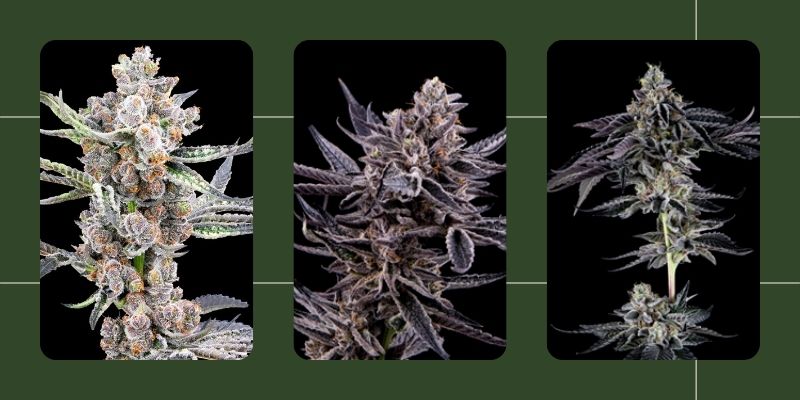Growing healthy cannabis plants requires making sure your plants have the proper nutrients, lighting, soil, or hydroponic conditions just right for healthy plants that produce a nice yield. Cannabis leaves are like windows into the health of your plants, and every cannabis cultivator should understand the valuable insight that cannabis leaves provide into your plant’s well-being. Growers must pay close attention to the leaves on their cannabis plants that can provide an early indication of problems, and then act quickly to ensure a successful and bountiful harvest.
Types of Cannabis Leaves
The cannabis leaves of different types of cannabis will appear differently. For example, the fan leaves of a Sativa plant will have more slender fingers than the leaves of Indica, which are wider. Sativa plants also have leaves that are of a lighter green color, whereas indica leaves are darker green. The Indica leaves are darker because they contain more chlorophyll, which is why many believe the Indica plants have a quicker growth cycle than Sativa. As long as you know what your plant leaves are supposed to look like, you can better diagnose any problems that may arise.
Common Problems That Weed Leaves Can Tell Us
Nutrient Deficiencies
One of the most common issues that cannabis plants face is nutrient deficiencies. Nutrient deficiencies can manifest in various ways, and their effects are often visible on the leaves. For example, a nitrogen deficiency will cause the lower leaves to turn yellow, while a phosphorus deficiency will result in dark spots and a purplish coloration. All nutrients should display the amounts of nitrogen, phosphorus, and potassium, identified as N-P-K. If your plants are showing signs of a nitrogen deficiency, make sure you have the correct pH and increase nitrogen in your mix. Be aware that fan leaves will naturally turn yellow close to harvest time because they pull the nitrogen out of the leaves for one last growth spurt. This is completely normal and nothing to worry about.
Nutrient Burn
Nutrient burn occurs when plants receive an excess of nutrients. This can cause the tips of the leaves to turn brown and crispy. It is crucial to maintain a proper nutrient balance to avoid nutrient burn and ensure optimal growth. If your plants show signs of nutrient burn, stop feeding nutrients for a week or two to allow your plant to flush out the excess quantity.
Overwatering
Overwatering is a common mistake made by many growers. When cannabis plants are overwatered, their leaves may start to droop and develop yellow or brown spots. Overwatering can lead to root rot and hinder the plant’s ability to absorb nutrients effectively. Root rot is a serious problem that develops from overwatering and a lack of oxygen in the root zone.
High temperature and humidity in your grow room can also cause root rot and may contaminate your growing area or your water reservoir with fungus and bacteria. Cannabis leaves may turn yellow from root rot, they may appear to have irregular yellow patches, or it could affect just the edges. Your leaves may also wilt and crumble. Repair the foundation of your plants to allow oxygen in and reduce the number of waterings and the amount of water given at each feeding.
Underwatering
Conversely, underwatering can also cause issues for your cannabis plants. If the leaves appear dry, brittle and curled at the edges, it is a sign that your plants are not receiving enough water. It is essential to strike a balance and provide your plants with adequate hydration.
pH Imbalance and Nutrient Lockout
Maintaining the correct pH level is crucial for optimal nutrient absorption. If the pH is too high or too low, it can lead to nutrient lockout, where the plants are unable to absorb certain essential elements. This can result in discolored leaves and stunted growth. Make sure that your nutrient mix and waterings are at the correct pH level for your grow medium.
Light Burn
Cannabis plants require proper lighting for photosynthesis, but excessive light exposure can lead to light burn. The leaves closest to the light source may develop brown or yellow spots. Adjusting the height of your grow lights can help prevent this issue.
Pest Infestations
Pests such as spider mites, aphids, and whiteflies can wreak havoc on your cannabis plants. If you notice small holes, webbing, or discoloration on the leaves, it is a clear indication of a pest infestation. Early detection and appropriate pest control measures are crucial to prevent further damage. Learn the best methods to control pests with this Integrated Pest Management Guide.
Heat Stress
High temperatures can cause heat stress in cannabis plants. The leaves may curl or droop, and the overall growth may be stunted. Adequate ventilation and temperature control are essential to mitigate heat stress.
Mold and Mildew
Excessive humidity and poor airflow can create an environment conducive to mold and mildew growth. Affected leaves may display white or gray patches. Maintaining proper humidity levels and ensuring good air circulation are key preventive measures.
Genetics
Lastly, it’s important to consider the role of genetics. Some cannabis strains are more susceptible to certain issues than others. Choosing quality cannabis seeds from reputable breeders like Mosca Seeds can help minimize potential problems and improve overall plant health.
Cannabis leaves can tell you a great deal about the health of your plants. By paying close attention to their appearance, you can identify and address various growth issues early on. Whether it’s nutrient deficiencies, overwatering, pH imbalances, or pest infestations, timely intervention, and proper care can help ensure a successful and rewarding cannabis cultivation experience.
Start your grow with quality cannabis seeds from Mosca Seeds for a head start to growing healthy plants. Enjoy a wide selection of many seed types and strains, including Indica, Sativa, and hybrids in regular seeds, feminized, or autoflowers. Check out the Seed Bazaar today and get started on growing healthy cannabis plants.
